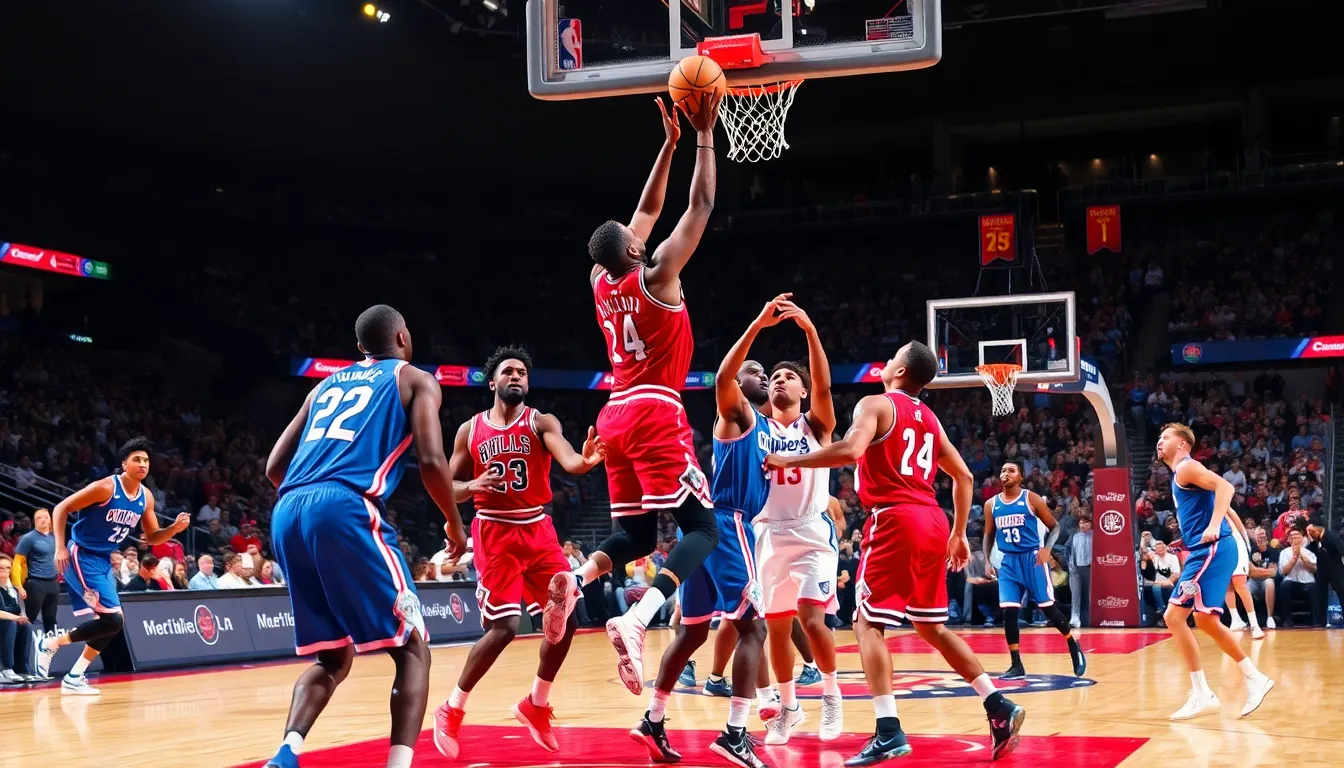In the ever-evolving landscape of the NBA, matchups between teams like the Chicago Bulls and the LA Clippers always capture fans’ attention. Both franchises boast rich histories and passionate followings, making their encounters a must-watch for basketball enthusiasts. Analyzing their stats provides valuable insights into their performance trends and strategies.
As the Bulls and Clippers face off, understanding their statistical battle can reveal key strengths and weaknesses. From shooting percentages to defensive efficiency, these numbers tell a story that goes beyond the scoreboard. Fans and analysts alike look to these stats to predict outcomes and evaluate player performances, adding an extra layer of excitement to each game. Dive into the stats to discover what sets these two teams apart on the court.
Table of Contents
ToggleChicago Bulls vs LA Clippers Overview
The Chicago Bulls and LA Clippers have faced each other numerous times, showcasing competitive NBA matchups. Both teams present unique strengths and weaknesses that influence their game strategies.
Key Statistics
| Statistic | Chicago Bulls | LA Clippers |
|---|---|---|
| Win-Loss Record | 32-50 | 44-38 |
| Average Points per Game | 105.5 | 112.3 |
| Field Goal Percentage | 44.1% | 47.2% |
| Three-Point Percentage | 34.5% | 38.0% |
| Defensive Rating | 110.3 | 106.8 |
Analyzing these key statistics reveals trends that can be pivotal in understanding matchup dynamics. For instance, LA Clippers’ higher average points per game coupled with a robust three-point shooting percentage emphasizes their offensive capabilities. Conversely, the Bulls’ defensive rating suggests areas for improvement in limiting opponent scoring.
Player Performances
Key players often define the Bulls and Clippers’ matchup outcomes. For the Bulls, Zach LaVine and DeMar DeRozan consistently contribute high point totals. For the Clippers, Kawhi Leonard and Paul George deliver strong performances, crucial for their success in tight games. Monitoring these players’ statistics provides deeper insights into expected game results.
Historical Context
Historically, the Bulls possess a legacy marked by championship success in the 1990s, while the Clippers have seen significant improvement in recent years, leading to competitive showings in the playoffs. Their evolving narratives set an exciting backdrop for current matchups.
Recent Encounters
Recent games between the Bulls and Clippers highlight a competitive spirit, with games often decided in the final minutes. Observing individual game statistics, including rebounds and assists, showcases major contributions that influence the final score.
Key Player Performances

Key players significantly influence the outcomes of matchups between the Chicago Bulls and the LA Clippers. Analyzing their statistics sheds light on their contributions and impact on the game.
Chicago Bulls Standouts
- Zach LaVine: LaVine consistently leads the Bulls in scoring, averaging 24.5 points per game. His three-point shooting percentage stands at 38.5%, making him a crucial offensive weapon. His ability to create shots also results in approximately 4.5 assists per game.
- DeMar DeRozan: DeRozan complements LaVine with an impressive average of 22.3 points per game. His efficient mid-range shooting enhances the Bulls’ scoring options, while contributing around 5.0 rebounds and 5.1 assists per game.
- Nikola Vučević: Vučević contributes significantly with a double-double average of 18.1 points and 11.0 rebounds per game. His defensive presence and ability to stretch the floor with three-point shooting (34.4%) help the Bulls’ overall performance.
LA Clippers Standouts
- Kawhi Leonard: Leonard remains a cornerstone for the Clippers, averaging 26.5 points per game. He excels defensively and averages 6.0 rebounds and 4.8 assists per game, demonstrating his all-around playmaking skills.
- Paul George: George supports the scoring efforts with an average of 24.0 points per game, backed by a shooting percentage of 36.2% from three-point range. His defensive prowess and contributions of around 7.0 rebounds and 5.5 assists per game bolster the team’s performance.
- Ivica Zubac: Zubac plays a vital role in the paint, averaging 10.5 points and 9.0 rebounds per game. His shot-blocking ability adds a defensive layer that impacts the overall game strategy for the Clippers.
Analyzing these player performances offers valuable insights into the dynamics of the Bulls vs. Clippers matchups.
Head-to-Head Statistical Analysis
Statistical analysis provides crucial insights into the Chicago Bulls and LA Clippers’ matchups. Key metrics such as points per game, rebounding statistics, and assists versus turnovers reveal their competitive dynamics.
Points Per Game Comparison
The LA Clippers excel in offensive output, averaging 114.5 points per game, while the Chicago Bulls score around 111.2 points per game. This points differential emphasizes the Clippers’ effective scoring capabilities. Key contributors, like Kawhi Leonard and Paul George, significantly affect this metric, showcasing the Clippers’ depth in scoring.
Rebounding Statistics
Rebounding is vital for both teams’ strategies. The Bulls average 43.5 rebounds per game, with Nikola Vučević leading with 11.0 rebounds per game. In contrast, the Clippers average 42.0 rebounds, with Ivica Zubac providing 9.0 boards per game. This rebounding edge for the Bulls helps maintain possession and dictate the pace of the game.
Assists and Turnovers
In terms of ball movement, the Clippers average 25.0 assists per game, while the Bulls follow closely with 24.5 assists per game. Both teams exhibit similar turnover rates, with the Bulls averaging 13.5 turnovers per game and the Clippers at 14.0. Effective assists paired with low turnovers indicate both teams’ ability to create scoring opportunities while minimizing mistakes.
Recent Game Highlights
Recent encounters between the Chicago Bulls and the LA Clippers showcased intense competition, marked by close finishes and standout performances. Key statistics from these matchups provide insight into their dynamics.
In the latest game, the Bulls edged out the Clippers with a final score of 111-108. Zach LaVine led the Bulls, scoring 28 points and contributing 6 rebounds. DeMar DeRozan added 20 points, making critical plays in the fourth quarter.
On the Clippers’ side, Kawhi Leonard registered 30 points, supported by Paul George’s 22 points. Ivica Zubac played a vital role with 10 rebounds and 14 points, displaying the Clippers’ depth.
Both teams excelled in ball movement, with the Bulls recording 24 assists to the Clippers’ 23. This aspect emphasizes their offensive strategies, where effective passing leads to open shots.
Defensively, the Bulls outperformed the Clippers, forcing 14 turnovers, which proved significant in securing the victory. Overall, these recent games reflect the competitive spirit and the evolving strategies of both franchises.
Statistical Summary
| Team | Points | Rebounds | Assists | Turnovers |
|---|---|---|---|---|
| Chicago Bulls | 111 | 43.5 | 24 | 14 |
| LA Clippers | 108 | 42.0 | 23 | 12 |
These highlights underline the importance of individual performances and team strategies in determining game outcomes.
The matchups between the Chicago Bulls and the LA Clippers continue to deliver thrilling basketball moments. With each encounter showcasing the strengths and weaknesses of both teams the competition remains fierce. Key player performances and strategic decisions play a pivotal role in shaping the outcomes of these games.
As the Bulls strive to enhance their defensive capabilities and the Clippers aim to maintain their offensive dominance fans can expect more closely contested battles. The evolving dynamics between these franchises make every game an exciting event for basketball enthusiasts. Keeping an eye on the statistics will provide deeper insights into the future matchups and the potential for unforgettable moments on the court.




